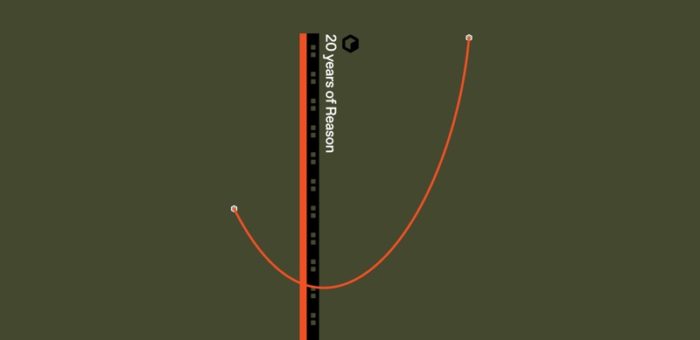
Reason 1.0 was released on November 22, 2000. I fell in love with the program and bought it straight away. Although it lacked audio recording, I preferred it over Cubase. I loved the interface, loved the tightly integrated sound devices and effects and was impressed by its rock stable performance.
Cubase at the time was very unstable, mostly because of plugins, which felt strange because on the Atari it used to run flawlessly. So Reason was definitely the next step for making music. Bye bye Cubase, welcome Reason!
And man did I love the Factory SoundBank! Back in the day I used Roland D110 and U220 devices. Those devices were so clean and dull sounding. But the sounds that were included in the Factory SoundBank were not clean at all. The included DrRex loops for example, Chemical Loops, Abstract HipHop and so on, mostly done by eLAB, had a grittiness to them which sounded retro and modern at the same time. Reason inspired many musicians and bands. Among who Liam Howlett of The Prodigy:
If Reason hadn’t come along I would probably still be in my studio, depressed, going “aww bloody ‘ell, don’t know what I’m gonna do”, you know? I don’t want to pat Propellerhead on the back too much, but… Reason has literally changed my life, getting me back in the studio and enjoying it all again. It’s taken the monotony out of music making and put it into a format where music should be these days – no big deal, just something that should be fun to do. Creation is always painful, but this is the least painful way I know of.
The Prodigal Reasoner by Fredrik Hägglund
When I started my company Melodiefabriek in 2003, soon I got asked by Propellerhead to design patches for Reason. And the rest is history…
Till this day I am very much involved with Reason, as a patch designer and with doing beta testing Reason and Rack Extensions.
To celebrate those 20 years Reason Studios gives away a Goodie Bag, a free downloadable zip which includes the very first Reason demo songs, two ReFills and more. In the effects section of the Reason20 Community ReFill 15 of my patches are included. You can recognise them by the naming tag ‘byM’.


3 Comments
My experience at the time with Cubase was the same. It was unstable due mostly to the then new VST echnology. I bought the D-Pole plugin and while it worked pretty well, it would crash the system frequently. Most people using Cubase then spent a lot of time in the Drum Editor which was and is a nice feature. The audio editing was okay. At the same time I had the first Pro tools Mbox which performed better though plugins could be expensive. Anyway, with Reason I could replace large parts of my workflow and experience stable performance. I also used an Akai S2000 with the additional filter board and connected it to my computer via SCSI so I could ship ReCycle slices back and forth. With Reason and Dr. Rex I could just chop up files and move them straight into Dr. Rex. I used the S2000 less and less and finally sold it. I didn’t give up on hardware though as I had a number of Emu “rom plers” of the time (Audity 2000, Planet Phatt, etc).
One more thing I wanted to add but forgot. Many newcomers to Reason (say in the past 5 years) see the flexible routing options as more of an annoyance than a benefit. As an example, a younger producer friend of mine uses BitWig and showed me how it set up sensible default LFO modulations without manual routing. It then occurred to me that being as old as I am (well not that old ha ha) it was natural for me to use patch bays and cables to route things in the studio hence Reason was fairly miraculous in that I could do it in software. Of course, my young friend has never really seen (or had to deal with) a large rack(s) of samplers, effects modules, sub-mixers compressors, etc let alone the patchwork necessary to do routing. (I’ve spent hours tracking down faulty cables and patch bay ports). So, it’s clear that what was originally a true innovation, Reason 1.0, is not necessarily seen as such by those who grew up with software DAWs and increasing computer stability. Reason still has validity beyond that of course but just wanted to make that observation.
And what is interesting is that the Players are more abstract devices. There’s no connection. Some users have opted a MIDI cable which would make sense. And the SSL mixer is unconnected as well. Wondering what will happen in let’s say ten years from now.
By Post Author